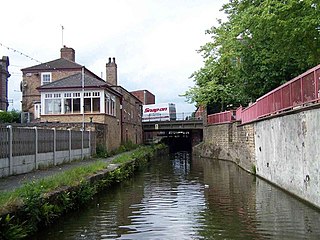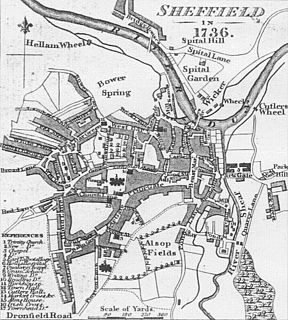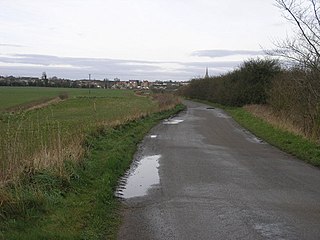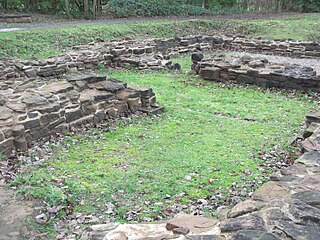William de Lovetot, Lord of Hallamshire, possibly descended from the Norman Baron Ricardus Surdus, [1] was an Anglo-Norman Baron from Huntingdonshire, often credited as the founder of Sheffield, England. [2]

Hallamshire is the historical name for an area of South Yorkshire, England, in the current city of Sheffield.

The Anglo-Normans were the medieval ruling class in England, composed mainly of a combination of ethnic Anglo-Saxons, Normans and French, following the Norman conquest. A small number of Normans had earlier befriended future Anglo-Saxon King of England, Edward the Confessor, during his exile in his mother's homeland of Normandy. When he returned to England some of them went with him, and so there were Normans already settled in England prior to the conquest. Following the death of Edward, the powerful Anglo-Saxon noble, Harold Godwinson, acceded to the English throne until his defeat by William, Duke of Normandy at the Battle of Hastings.
Baron is a rank of nobility or title of honour, often hereditary. The female equivalent is baroness.
It is unknown when De Lovetot acquired an interest in the manor of Hallamshire, but by the early twelfth century (in the reign of Henry I) he was in possession of Hallam, Attercliffe, Sheffield, Grimesthorpe, Greasbrough and Worksop. He also had interests in Handsworth, Treeton, and Whiston . He founded a priory at Worksop c.1103, St. Mary's Church at Handsworth, and may have founded the parish church in Sheffield at around this time.
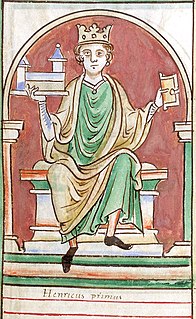
Henry I, also known as Henry Beauclerc, was King of England from 1100 to his death in 1135. Henry was the fourth son of William the Conqueror and was educated in Latin and the liberal arts. On William's death in 1087, Henry's elder brothers Robert Curthose and William Rufus inherited Normandy and England, respectively, but Henry was left landless. Henry purchased the County of Cotentin in western Normandy from Robert, but William and Robert deposed him in 1091. Henry gradually rebuilt his power base in the Cotentin and allied himself with William against Robert. Henry was present when William died in a hunting accident in 1100, and he seized the English throne, promising at his coronation to correct many of William's less popular policies. Henry married Matilda of Scotland but continued to have a large number of mistresses by whom he had many illegitimate children.

Attercliffe is an industrial suburb of northeast Sheffield, England on the south bank of the River Don. The suburb falls in the Darnall ward of Sheffield City Council.

Greasbrough is a small suburb in Rotherham, in South Yorkshire, England. The suburb falls in the Wingfield Ward of Rotherham Metropolitan Borough Council. Greasbrough had its own local council, Greasbrough UDC, until its absorption into the County Borough of Rotherham in 1936.
Lovetot is credited with the building of a motte and bailey castle in Sheffield. Along with the castle, a hospital was established at what is still called "Spital Hill", a mill was built beside the River Don, and a bridge called Lady's Bridge was constructed where there had previously only been a ford across the river. Little is known of Sheffield prior to Lovetot, but these developments established Sheffield as the main town in the Hallamshire area.

Sheffield Castle was a castle in Sheffield, England, constructed at the confluence of the River Sheaf and the River Don, possibly on the site of a former Anglo-Saxon long house, and dominating the early town. A motte and bailey castle had been constructed on the site at some time in the century following the Norman Conquest of England in 1066. This was destroyed in the Second Barons' War. Construction of a second castle, this time in stone, began four years later in 1270.
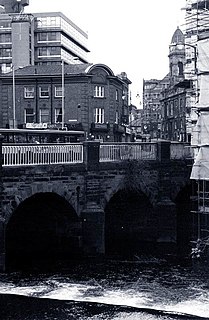
Lady's Bridge is the oldest bridge across the River Don in the City of Sheffield, England. It is located in the central section of the city, linking the Wicker to the north with Waingate to the south.
William had four sons, with his wife Emma; Richard, Nigel, [3] Henry and Hugh. [1]
Following the death of William de Lovetot the manor of Hallamshire passed to his elder son, Richard de Lovetot, and then to Richard's son, William de Lovetot, before being passed to Gerard de Furnival by his marriage to Maud de Lovetot in about 1204.
Gerard de Furnival (c.1175–1219) was a Norman knight and Lord of Hallamshire and Worksop. De Furnival's father was also called Gerard de Furnival, and had fought with Richard I at the Siege of Acre.
